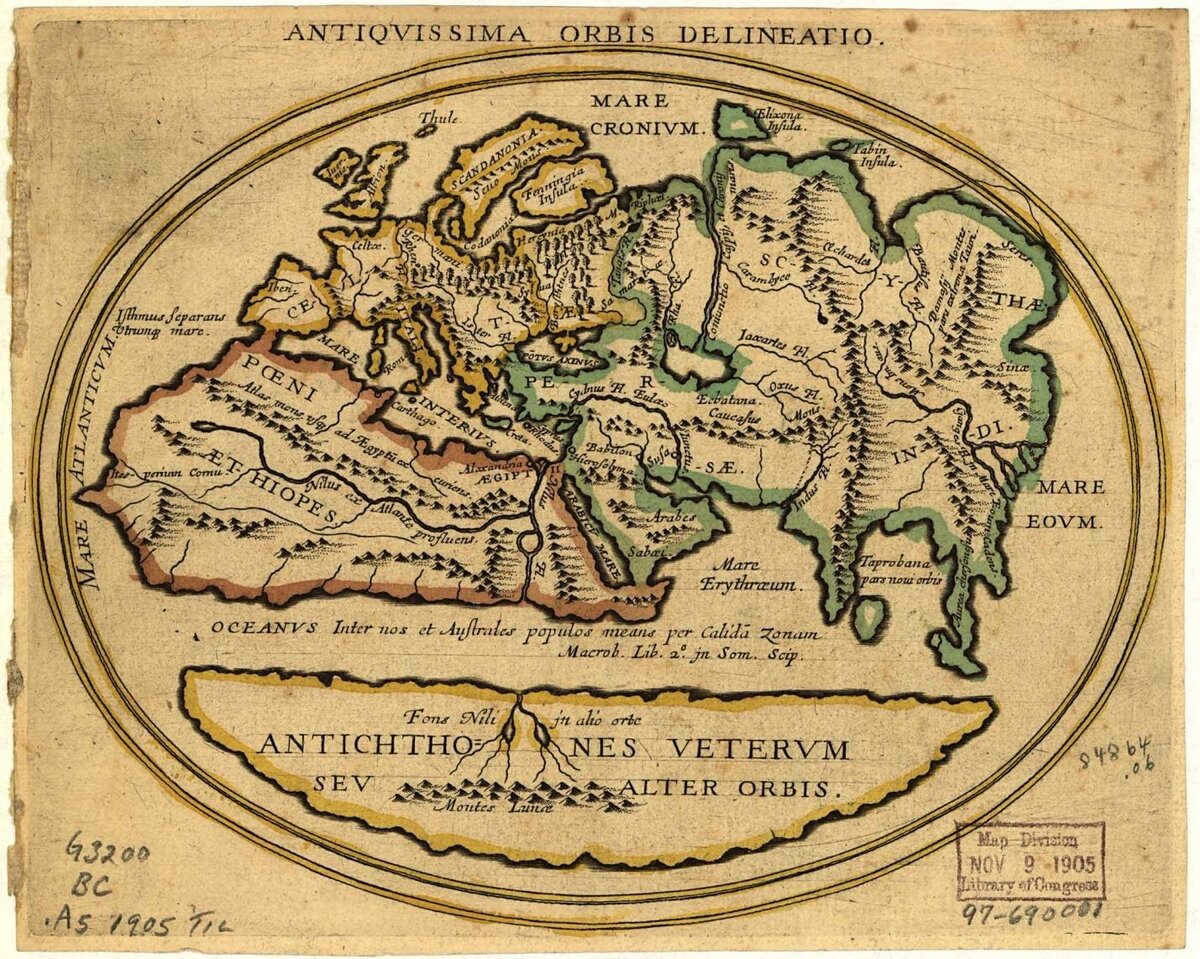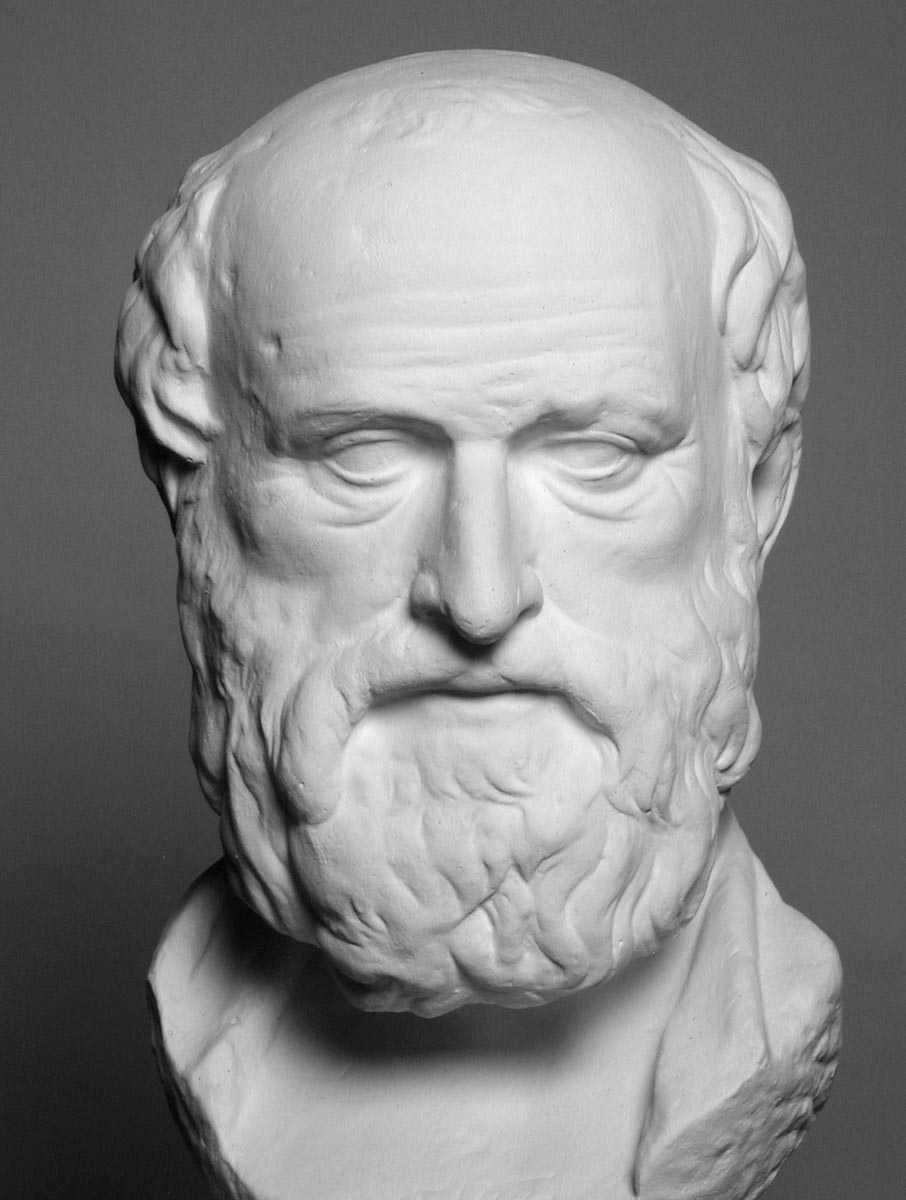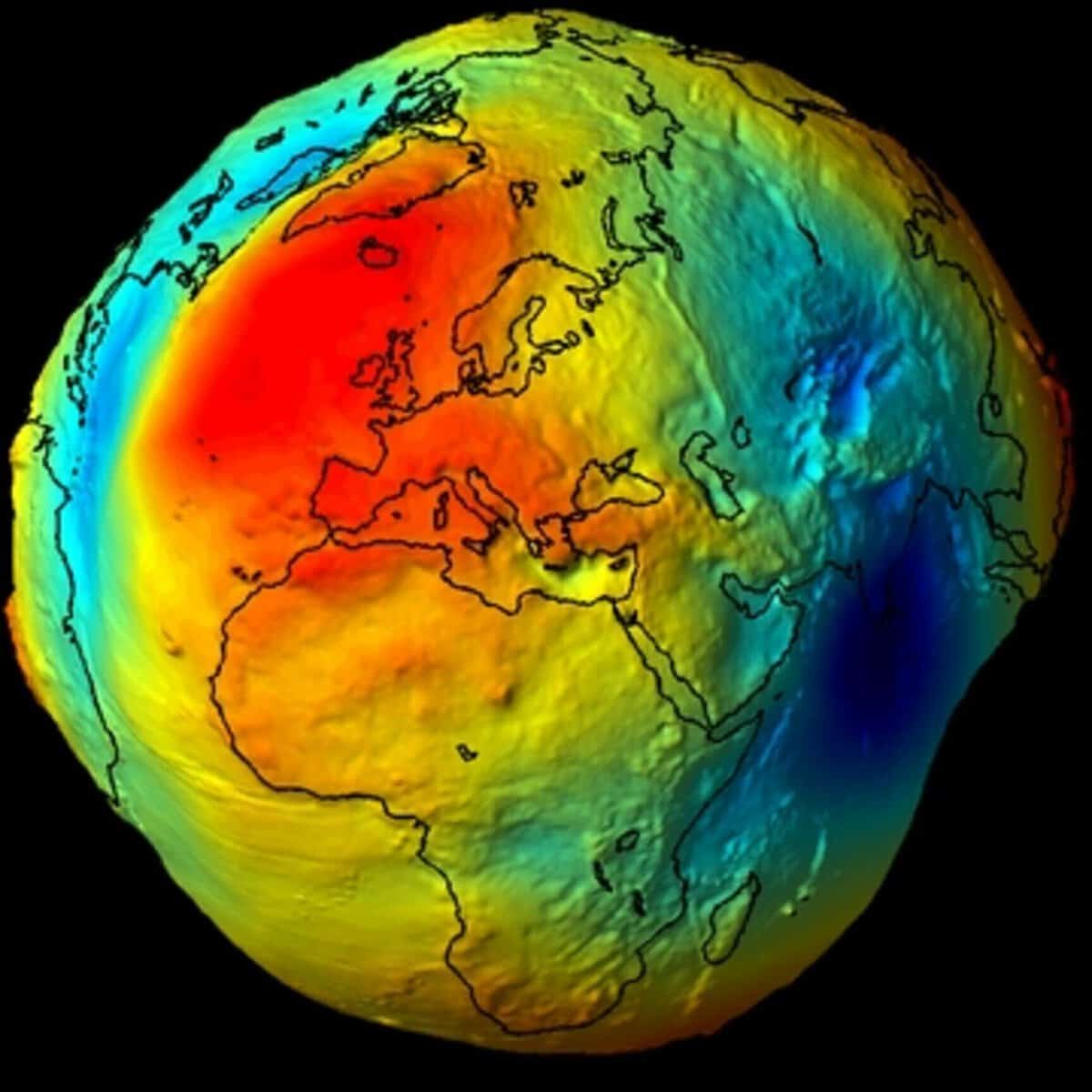2,500 years ago, the Greeks hypothesized that the Earth is not a flat disk. Aristotle later presented compelling evidence to support this theory.
During the time of Homer and for many centuries afterwards, the Greeks held the belief that the Earth was flat, taking on the shape of a disk. Notably, Thales, Herodotus, Anaxagoras, and Democritus all wrote about this. However, Pythagoras was the first to propose the idea that the Earth was actually spherical, towards the end of the 6th century B.C. It is uncertain whether he provided any evidence to support this hypothesis. Nevertheless, Greek mathematicians began developing a model consisting of two spheres – the celestial sphere and the terrestrial sphere. This model was most extensively described by Aristotle in his treatise “On the Sky” around 350 B.C. Aristotle was also the first to present a number of logical arguments in favor of the notion that the Earth was indeed spherical.
Aristotle held the belief that the sky is in a perpetual state of rotation, resulting in the repetitive movement of the celestial bodies. This phenomenon is what gives the sky its perfectly round appearance. Meanwhile, according to Aristotle, the Earth is situated at the center of the universe and remains stationary. Furthermore, he posits that the Earth is also spherical in shape. What evidence does Aristotle present to support his claim of the Earth’s sphericity?
Argument One: “Necessity”
To begin with, the initial premise was that the Earth acts as the central point in the universe, with all objects naturally gravitating towards its core. According to Aristotle, if a stone is thrown upwards, it will eventually fall back down, regardless of the force used, and its landing spot will remain unchanged. The philosopher postulated that if the Earth was not the center of the universe and instead moved through space, then a stone thrown forcefully would fall perpendicularly. Although Aristotle’s assumption was incorrect, he did arrive at the correct conclusion regarding the Earth’s shape: “The Earth must inherently be spherical” due to the inherent tendency of all matter to converge towards its center. This implies that the materials composing the Earth naturally gathered around a central point and inevitably formed a spherical shape. Furthermore, since the Earth remains motionless, it retains its spherical form.

An additional argument supporting this line of thinking is that the surrounding spherical objects, such as the Earth and the sky, must also be spherical. This means that both the stars and the Moon are round. It can be said that what is true for one celestial body is true for all, and visual observations confirm that the moon is indeed spherical. Furthermore, this fact is supported by astronomy, as the shape of the moon during solar eclipses would not be crescent if it were not spherical. Therefore, since one celestial body is spherical, it is logical to conclude that others are as well. This is because these celestial bodies are formed in the same space under similar conditions, leading to similar shapes.
"Moreover," Aristotle affirms, "[the Earth’s sphericity] can be confirmed through sensory experience. If the Earth were not a sphere, lunar eclipses would exhibit a distinct appearance, and "during eclipses, the boundary line always takes the form of an arc." The inference is straightforward: "Hence, since the Moon becomes obscured due to its position behind the Earth, the reason for [such] shape is the Earth’s roundness, and the Earth is indeed spherical". Astonishingly, advocates of the flat Earth theory propose a counterargument: if the Earth is a sphere, why doesn’t the horizon have an arc shape? It was discovered (and it was not immediately grasped), that in order to perceive the shape of an object, one must observe not the object itself, but rather its shadow. This constitutes the most elegant and simple demonstration!

Argument Three: “…the study of celestial bodies.”
Aristotle also discovered another evidence in the celestial sphere: “Furthermore, the observation of the celestial bodies provides indisputable proof that not only is the Earth spherical, but it is also of a small size. By journeying slightly to the south or north, the horizon noticeably alters: the arrangement of the stars above undergoes significant changes, and different stars become visible depending on the direction of movement. Consequently, certain stars that can be seen in Egypt and the region of Cyprus are not visible in the northern lands, while the stars that are consistently visible in the northern lands set in the aforementioned regions. From this, it becomes evident that the Earth is not only spherical but also a diminutive sphere. Otherwise, we would not have observed such rapid changes resulting from such minimal movement.”
These pieces of evidence were sufficient to dispel the belief in a “flat Earth” – at least among the educated population and prior to the Middle Ages. Ever since the time of Aristotle, there has been virtually no doubt among scholars regarding the Earth’s spherical shape. In the 3rd century BC, Eratosthenes further supported Aristotle’s assertion by using a stick and the sun’s shadow (which varies in length simultaneously in different cities due to the Earth’s curvature) to calculate the equator’s length in increments: 41,750 kilometers. Eratosthenes only made a slight error, as the actual length of the equator is 40,075 km.

In the 2nd century B.C., Kratet of Malos created the first globe. This invention sparked the curiosity of many, including Christopher Columbus, who would later embark on his famous journey across the ocean. Interestingly, Aristotle also pondered the idea, stating, “Those who believe that the area of Hercules’ Pillars is contiguous with the area of India and that in this sense the ocean is one, I think, adhere to not so incredible views.”
Despite the passage of time, the concept of the Earth as a sphere persisted throughout the Middle Ages. Numerous Christian thinkers, such as Origen, Ambroski, Thomas Aquinas, and Bede the Honorable, inherited this knowledge from the Greeks and Romans. However, those who placed more trust in the Old Testament found themselves in disagreement with these thinkers. The biblical revelation contradicted the ancient tradition, leading to debates and conflicts between religion and science once again.
- Shchetnikov A.I. The Evolution of Earth’s Perception: From the Ancient Greeks to the Era of Major Geographic Discoveries // Schole. Philosophical Antiquity and the Classical Tradition. 2012, Vol. 6, No. 2
- Aristotle. On the Concept of the Celestial Sphere (c. 350 BC).
- Marantidi E. The Ancient Greeks’ Contribution to Geography: Unveiling the Flat Spherical Earth. Interview with antiquarian Alexander Podosinov // Gorky [gorky.media].
What is the shape of our planet? 3333 challenging questions with answers
What is the shape of planet Earth?
The Earth is not a perfect sphere, but rather it is slightly flattened at the poles. In general, it is believed that the true shape of our planet is akin to a spheroid, which is a three-dimensional figure formed by rotating an ellipse around its minor axis. The equatorial radius of this spheroid measures 6378.160 kilometers, while the polar radius measures 6356.774 kilometers. The difference between these two measurements is 21.383 kilometers. If we were to construct a model of the Earth with an equatorial diameter of 1 meter, the polar diameter would be 997 millimeters. More precise studies have revealed that the Earth’s equator is not a perfect circle, but rather an ellipse. The major axis of this ellipse is 213 meters longer than the minor axis and is oriented towards a longitude of 7 degrees west of Greenwich. Through the use of highly accurate geodetic measurements, satellite observations, and gravimetry data, scientists have developed a more precise representation of the Earth’s shape known as the geoid. The geoid is not a perfectly geometric figure, but rather a surface that is perpendicular to the plumb line at each point (also referred to as a level surface).
It approximately corresponds to the undisturbed surface of the oceans, conceptually extended to the portion of the Earth’s surface occupied by landmasses (e.g., through hypothetical canals connecting all continents from one ocean to another). Elevation of different points on Earth is measured from the geoid’s surface, taking into account the altitude above sea level and the depth of the ocean. The investigation of the movement of man-made satellites orbiting the Earth has enabled us to establish that the southern pole of the geoid is 30 meters closer to the center compared to the northern pole.
The configuration of our planet Assumptions regarding the form of the Earth
Over the course of countless ages, the enigma of our planet’s shape has captivated the minds of humanity. It stands as a pivotal query, not solely within the realms of geography and ecology, but also within the domains of astronomy, philosophy, physics, history, and even literature. Throughout the ages, erudite scholars, particularly those of antiquity and the enlightenment era, have dedicated their endeavors to unraveling this enigmatic enigma.
The Theories of Scientists Regarding the Shape of the Earth
In the 6th century BC, Pythagoras and other ancient philosophers believed that the Earth is spherical in shape. Parmenides, Anaximander of Miletus, Eratosthenes, and many others also shared this belief. Aristotle conducted various experiments and was able to provide evidence for the round shape of the Earth. During lunar eclipses, the shadow cast on the Moon is always circular, supporting the theory of a spherical Earth. However, at that time, there were debates between those who believed the Earth was flat and those who believed it was round. Therefore, the theory of Earth’s sphericity, although accepted by many thinkers, required significant revision.
The contemporary understanding of the Earth’s form
Countless generations of scientists have conducted extensive research to determine the exact shape of our planet. It wasn’t until the first space flight that all the misconceptions were finally dispelled. Today, it is widely accepted that the Earth is shaped like an ellipsoid, although it deviates significantly from a perfect sphere, being flattened at the poles.
For various scientific and educational purposes, a globe is used as a model of the Earth. However, this representation is highly simplified. It is challenging to accurately depict all the geographical features of our planet on its surface, taking into account their scale and proportions. When it comes to calculations involving the Earth’s radius, the value of 6371.3 kilometers is commonly used.
When it comes to astronautics and geodesy, the concept of an ellipsoid of rotation or geoid is employed to describe the shape of the planet. However, the Earth also deviates from the geoid at different locations. Different models of Earth ellipsoids, such as the reference ellipsoid, are then utilized to address various problems.
Therefore, determining the shape of the planet remains a complex matter even for modern science, which has intrigued humans since ancient times. While we can venture into space and observe the Earth’s shape, precise depiction of its figure still requires further mathematical and other calculations, as our planet is unique and does not possess a simple geometric shape.
Ancient Theories and Contemporary Scientific Investigations
Countless inquiries reside in the Milky Way, yet the structure of the Earth remains undisputed. Our planet assumes the form of an ellipsoid, resembling an ordinary sphere, albeit slightly compressed around the polar regions: the North and South Poles. This notion of Earth’s shape developed over centuries through a intricate interplay between faith and empirical inquiry. Presently, any pupil in primary school can accurately respond to this inquiry.
Evolution of Knowledge about the Earth’s Shape
The quest to determine the true shape of the Earth has been a subject of extensive debate in the realm of natural scientific knowledge. Throughout history, various theories have emerged. Homer proposed that the Earth was circular, while Anaximander argued for a cylindrical shape. Many of us may recall the captivating images from our fifth-grade atlas depicting the Earth as a disk resting on a turtle, which in turn is supported by three elephants, and so on. At one point, there were even suggestions that our planet was either floating like a boat on a vast ocean or towering over it in the form of the tallest mountain!
Variations in the Earth’s movement
Throughout the course of human history, there have been numerous changes in the understanding of our home planet’s shape and its motion. In the late 19th century, the prevailing belief was that the Earth was completely stationary. However, official scientific thought eventually shifted to the idea that the Sun revolved around the Earth, rather than the other way around. This topic, concerning the shape and movement of the Earth, has captivated not only scientists but also the general society throughout different eras. One striking example of this is the tragic execution of D. Bruno, whose views on the Earth’s motion diverged from the accepted consensus at the time. Unfortunately, official science did not always embrace progressive discoveries, instead favoring the well-trodden path of religious beliefs. It was the Polish scholar N. Copernicus who first proposed the truly accurate hypothesis that our planet revolves around the Sun, rather than the Sun revolving around our planet.
Recent discoveries
F. Bessel, a German scientist, was the first to accurately determine the compression of the Earth at the poles in the 19th century. For hundreds of years, his calculations remained unchallenged. However, in the 20th century, F.N. Krasovsky, a Soviet scientist, published new and more precise data that surpassed the earlier findings. As a result, the ellipsoid representing the Earth’s dimensions was named after him. The Earth’s shape is indeed a sphere, but it is slightly flattened at the poles, with a difference of 21 kilometers between the equatorial and polar radii. This measurement has remained consistent since 1936.
Summary
According to the most recent scientific data, the Earth is best described as a geoid, which is the most accurate representation of its shape. The geoid closely resembles the true model of the Earth, with its depressions and elevations. Further research conducted by Russian scientist A.A. Ivanov suggests that the Earth’s hemispheres lack symmetry, and the equator is actually an ellipse rather than a circle. These findings demonstrate the continuous development of scientific knowledge, and it is intriguing to consider what else we may discover about our home planet in the next century. In the meantime, the familiar globe remains a staple in classrooms worldwide, allowing us to explore the wonders of the Earth.
What is the shape of our planet?
What shape does our planet have?
What is the shape of our planet?
Our planet is called Earth.
Let’s explore the topic of our natural science lesson, “Planet Earth: its orbit around the Sun and the cycle of day and night.” Watch the video to learn more.
The current shape of Earth in 2017
The shape of Earth refers to the form of its surface. Different definitions can be used to describe the shape of our planet.
What is the true shape of the Earth?
Everyone knows that the Earth is round. It is common knowledge that the Earth is shaped like a sphere and that gravity keeps us grounded within the atmosphere. However, not everyone has always believed this.
The concept of the Earth being spherical has been around for a long time. It was first proposed by the ancient Greek philosopher and mathematician Pythagoras in the 6th century BC. Another philosopher, Aristotle, who lived two centuries later, provided visual proof of the Earth’s round shape: during lunar eclipses, the Earth casts a round shadow on the Moon!
Gradually, the concept that our planet was a spherical object suspended in the vastness of space became more widely accepted. Over the centuries, it has become common knowledge that the Earth is not flat and does not rest on the backs of whales or elephants. We now know that not only our planet, but also the other planets in the universe, are “round” in shape due to their size and significant mass. This is because they possess their own gravitational force, known as gravity, which constantly pulls all celestial bodies towards a spherical configuration.
In the 17th century, the renowned physicist and mathematician Newton boldly proposed the idea that the Earth is not a perfect sphere, but rather a slightly irregular shape. He envisioned two interconnected channels drilled from the North Pole and the equator, which he filled with water. Through his calculations, Newton discovered that the water in the polar well was only influenced by gravitational force, while the water in the equatorial well was also counteracted by the centrifugal force. Newton concluded that in order for both columns of water to exert equal pressure and have the same weight, the water level in the equatorial well must be higher by 1/230 of the average radius of the Earth. In simpler terms, the distance from the equator to the center of the Earth is greater than the distance from the pole to the center.
To experimentally verify Newton’s calculations, the Paris Academy of Sciences organized two expeditions to Lapland and Peru from 1735 to 1737. The participants of these expeditions measured one-degree arcs of the meridian: the first in Peru, at equatorial latitudes, and the second in Lapland, at polar latitudes. After processing all the data, geodesist Pierre-Louis Maupertuis, the leader of the polar expedition, officially confirmed that Newton was correct: our planet is indeed compressed at the poles! Therefore, we now understand that the Earth is slightly flattened at the poles and elongated at the equator. The difference is minimal, with the polar radius measuring 6357 km and the equatorial radius measuring 6378 km, a difference of only 21 km.
However, can we simply refer to our planet as an ellipsoid of rotation instead of a sphere? The Earth’s surface is not uniform due to the presence of mountains and depressions. It is also influenced by the gravitational forces of other celestial bodies, particularly the Moon and the Sun. Although their effects are relatively small, the Moon can cause variations in the shape of the world’s oceans by several meters through tidal forces. This means that the radii of rotation differ at different points on the Earth. Additionally, there is an ocean in the north and the icy continent of Antarctica in the south. Consequently, our planet does not possess a perfectly regular shape, but rather resembles a pear that is slightly elongated towards the North Pole. Moreover, the Earth’s surface is so intricate that it cannot be accurately described using classical mathematics. As a result, scientists have coined a special term for the shape of the Earth – geoid. The geoid is an irregular three-dimensional figure that approximately corresponds to the vast expanse of the World Ocean and extends over the continents. The “altitude above sea level” is calculated based on this geoid surface.
What is the shape of the planets in the solar system?
The planets in the solar system have a spherical shape.
How do they differ in terms of size?
The planets in the solar system vary in size. The terrestrial planets (Mercury, Venus, Earth, Mars) are composed of solid materials and are relatively small in size. On the other hand, the gas giant planets are known for their enormous size.
1. What is the most compelling evidence for the spherical shape of Earth?
The most compelling evidence for the spherical shape of Earth comes from the observations, images, and measurements taken from space.
2. How have people’s perceptions of Earth’s shape changed over time?
It wasn’t immediately recognized by people that the Earth had a spherical shape. In India, the locals believed that the Earth was half of a ball that was held up by elephants or gigantic turtles. The Greeks viewed the Earth as a convex disk. However, even the Babylonians and ancient Indians had an inkling of the Earth’s convexity. Evidence of our planet’s spherical shape was gradually accumulated. Aristotle and Pythagoras already saw the Earth as a sphere.
3. What are the indicators that describe the size of the Earth? What are the values of these indicators?
The size of the Earth is described by the following indicators: polar radius – 6357 km, equatorial radius – 6378 km, circumference of the equator – 40076 km, surface area of the Earth – 510 million km2.
4. How does the shape and size of the Earth impact the planet’s existence?
The Earth’s size enables it to support an atmosphere and bodies of water, allowing for the existence of life. The spherical nature of the Earth results in varying angles at which the sun’s rays fall on it, leading to the development of diverse climate conditions. The temperature of the Earth rises from the poles to the equator, giving rise to different climates and consequently, different environments.
Exploring the shape of the Earth, past hypotheses and present theories shed light on the true nature of our planet.
A brief history
Throughout history, humans have been curious about the world around them, pondering the mysteries of the sky, the earth’s firmament, and the vast bodies of water that surround it. This curiosity has led to the development of various theories and assumptions by philosophers and thinkers.
- In ancient Greece, it was believed that the earth was a flat plane, encircled by endless ocean waters. According to this belief, the sun god Apollo would ride his chariot across the sky, illuminating it. The stars were thought to sink into the ocean waters during the day and reemerge at night.
- In India, a different belief took hold. It was believed that the earth was supported by four elephants, which in turn stood on the back of a giant turtle. This turtle floated on a vast sea of milk, and the earth itself was said to be coiled by a massive snake.
- The Earth used to be compared to a suitcase by kids in elementary school, jokingly saying that they would meet you around the corner! However, the Chinese had a more serious belief that the Earth is actually shaped like a rectangle. According to their belief, the Earth rests on columns, with the immense sky above this structure. It is said that a passing dragon once bent one of the columns, causing the sun to no longer move evenly across the sky. Instead, it now follows a circular path, rising in the east and setting in the west.

- The earth is believed to have a square shape, with five trees located on it. The central tree is green and considered the most important, while the tree in the east is red, the one in the north is white, the one in the west is black, and the one in the south is yellow. According to the ancient Maya, these trees hold up the sky, with their color changing throughout the day to reflect the color of the sun.
- The universe is believed to consist of seven worlds, connected by a magnificent tree. This tree is our earth, and at its crown lies the island of Buyan, where the ancestors of all animals dwell. This was the understanding of the ancient Slavs.
- In ancient Egyptian beliefs, the earth was depicted with the Goddess of Soil resting below and the majestic Sun God floating above in the sky.
- Pythagoras, a renowned scientist from ancient Greece, was born around 586 BC – 569 BC. Despite not leaving behind any written works, we can gain insight into his thoughts and ideas through the writings of his students and followers. Pythagoras extensively traveled and studied under the guidance of Egyptian, Persian, and Phoenician sages. He approached the world with a scientific mindset and firmly believed that the Earth is spherical in shape.

- Pythagoras, the ancient Greek mathematician and philosopher, had a teacher named Anaximander of Miletus, who was known for his studies in cosmology. Anaximander wrote a scientific work called “On Nature,” in which he described the Earth as having two flat surfaces – one on which we walk and another opposite to it. According to Anaximander, the Earth is at the center of the universe and is not supported by anything. It is surrounded by rings of fire and is also surrounded by other planets at varying distances.
- Another ancient Greek scientist, Parmenides, who lived around 540 BC, also shared this view of the Earth in his writings. One of his surviving works is a poem called “On Nature.”
- Aristotle (384 BC), a student of Plato and the teacher of Alexander the Great, provided evidence that the Earth is spherical. He based his argument on the observation that during lunar eclipses, the shadow cast by the Earth is circular. Additionally, Aristotle demonstrated that the Moon itself is also spherical.
- Galileo Galilei, a renowned mathematician, physicist, astronomer, and philosopher, revolutionized our understanding of the universe by utilizing the telescope to observe the heavens. His groundbreaking discovery, which challenged the prevailing belief that the sun revolves around the Earth, instead proposing that the Earth revolves around the sun, caused significant controversy and led to his persecution by the Catholic Church.
“It is a preposterous belief, both philosophically and formally heretical, to claim that the Sun remains motionless at the center of the universe, as it directly contradicts the teachings of Holy Scripture.
Equally preposterous is the belief that the Earth is not at the center of the universe, that it is not stationary, and that it undergoes a daily rotation. This belief is false from a philosophical perspective and sinful from a religious standpoint.”
The scientist faced persecution and was accused of heresy. However, in 1972, the church reversed Galileo’s trial verdict, and in 1992, Pope John Paul II, representing the Roman Catholic Church, acknowledged that both the verdict and the accusation were mistaken.
At Present.
Isaac Newton, a physicist, engineer, mathematician, and astronomer, postulated the hypothesis that the Earth’s shape is not spherical but rather an ellipsoid. In order to substantiate his claim, he devised a hypothetical experiment. The experiment entails excavating two vertical tunnels to the Earth’s core: one from the pole and another from the equator. Both tunnels are then filled with water. Assuming the Earth is a perfect sphere, the length of the tunnels would be equal. However, in the equatorial tunnel, the water is subject to centrifugal force, whereas in the polar tunnel, it is not. In order for the two tunnels to remain in equilibrium, the equatorial tunnel must be longer in length.

When it comes to astronautics and geodesy, where precise calculations are of utmost importance, the geoid or ellipsoid is utilized. The former is associated with an astronomical coordinate system, while the latter is linked to geodetic purposes.
However, the Earth is not considered a complete geoid. If the planet’s surface were entirely covered with oceans that remained unaffected by tides, then it would resemble a geoid. In reality, the shape is different, which is why we have introduced the concept of a reference ellipsoid for a more accurate definition.
In the field of science and calculations, various Earth ellipsoids and the corresponding coordinate systems are employed.
Here are some resources for a 5th-grade lesson based on the textbook “Introduction to Geography” by Alexeevsky and Domogatsky. Included are images of historical depictions of the Earth’s shape and portraits of the pioneering scientists who first proposed the idea of a spherical planet.
Get the Download:
Preview it:
Captions for the Slides:
What is the shape of our planet? Teaching material for a 5th-grade geography lesson by Teacher Kobozeva Alla Mikhailovna.
This is how the Earth was depicted in ancient times in Russia.
The Ancient Greeks’ interpretation of the Earth.
And here is how they envisioned the Earth’s edge…
It’s astonishing… It’s not surprising that people long believed the Earth was flat like a table… What is surprising is that the human mind eventually discovered the true shape of our planet. However, it took many, many thousands of years for this realization to occur…
A sphere is a thing of beauty! Ancient Greek scientist and mathematician, Pythagoras.
Aristotle, the ancient Greek philosopher, discovered several proofs that the Earth was spherical.
Eratosthenes of Cyrene is credited with coining the term “geography” and was the first to create a book and map of the world. He was also the first to calculate the size of the Earth.
Fernand Magellan, a Portuguese navigator, lived from 1470 to 1521.
This is a photograph of the Earth taken from the Apollo 17 spacecraft.
Regarding: methodical developments, presentations, and notes
Class 1 of Russian Language. Topic: “Describing Appearance. Words that answer the questions “what?”, “what kind?”, “what kind?”, “what kind?”.
“Describing Appearance. Words that answer the questions “what?”, “what kind?”, “what kind?”, “what kind?”. “Elementary School of the 21st Century”.
Week of Open Doors at SBOU SOSH 623 Moscow. Lesson overview. Lesson topic: What’s That? What’s That? What’s That? What’s That? The aim of the lesson: to instruct children on accurately associating signs with objects, correctly matching words in .

Class hour “School uniform. What should it be?” for students in grades 8-10. The structure of the class and presentation.
As Anton Chekhov once said: “A person should be beautiful in every aspect: their face, their clothes, their soul, and their thoughts.” Today, let’s discuss the topic of clothing, specifically school uniforms. In the modern age, it is important for students to possess the ability to dress tastefully, demonstrating a sense of style and cleanliness.
Outline of the lesson “Deuteronomy as a unique verb form”
Overview of the lesson on the Russian language.
Investigation “What is the reason behind the conical shape of a fire bucket?”
Research conducted by a student in the 7th grade to explore the reasons behind the specific shape of a fire bucket.






